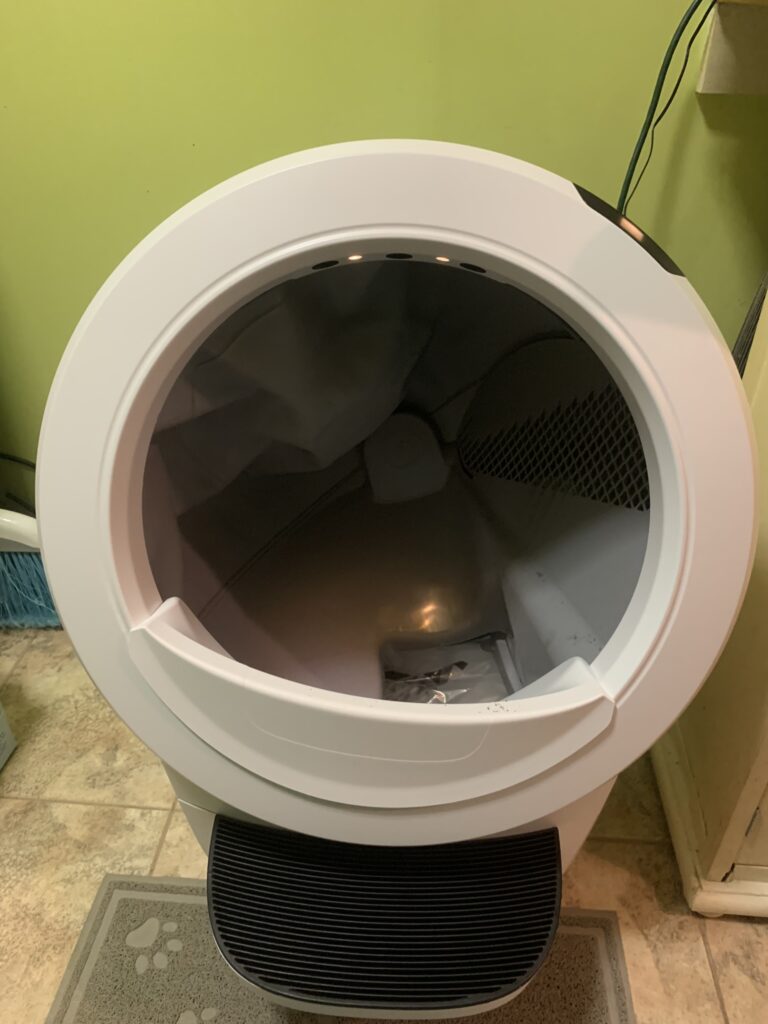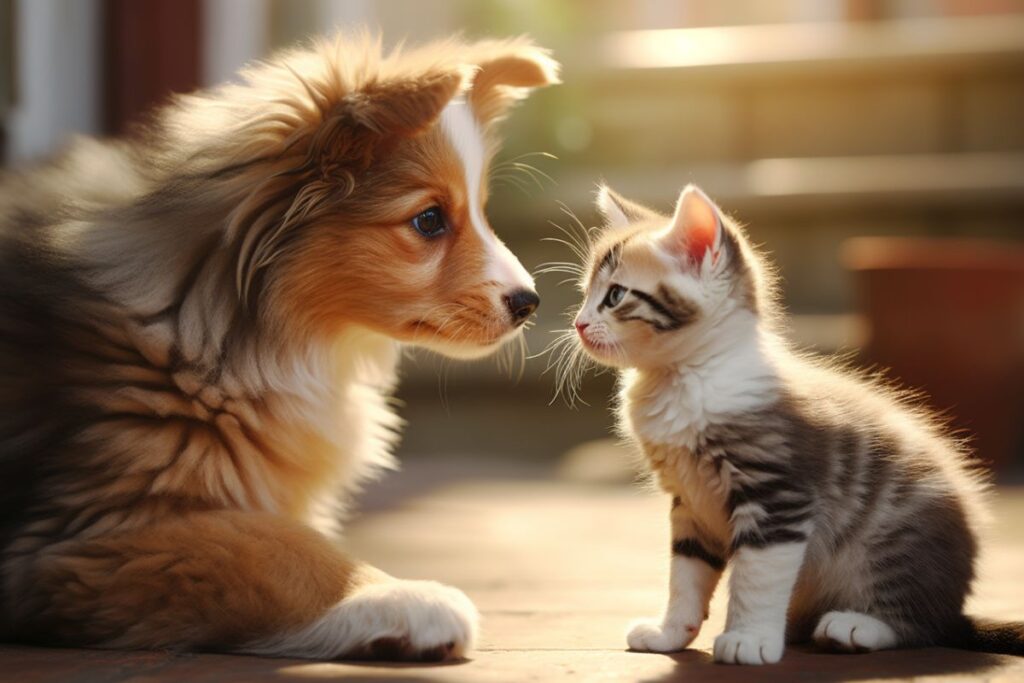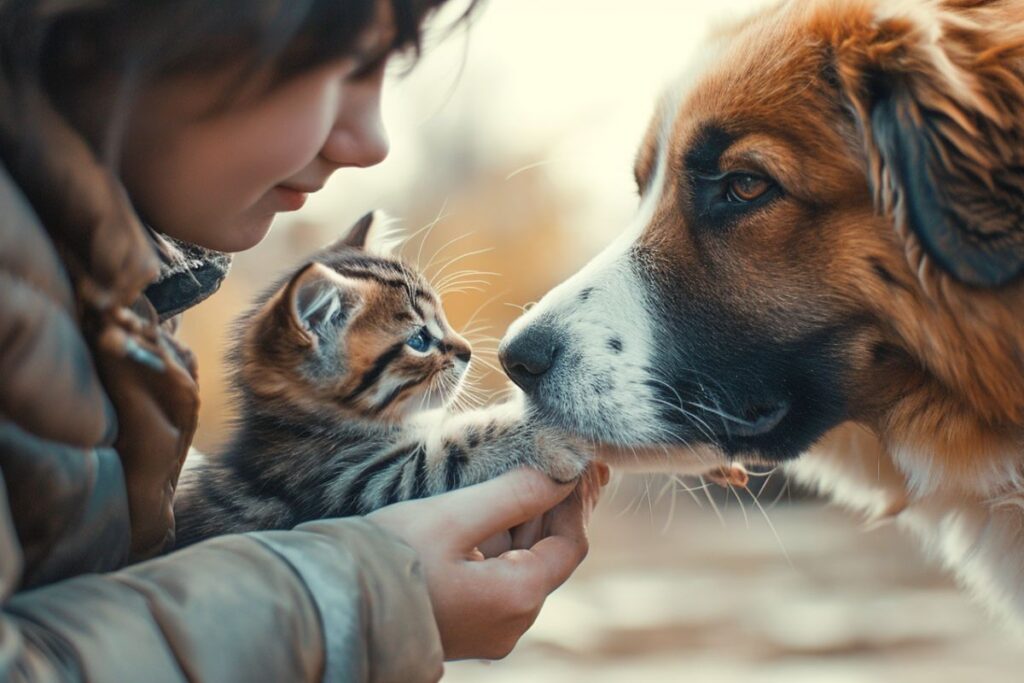Bringing a new furry friend into your home is an exciting adventure, but introducing a kitten to your dog can be a delicate process that requires thoughtful consideration. Whether you’re expanding your four-legged family or introducing a playful companion for your canine companion, the key is to ensure a smooth transition. Below, we’ll go through five essential steps to foster a harmonious relationship between your feline and canine companions. Let’s get started!

1. Consider Your Dog’s Temperament
Before introducing a kitten to your dog, it’s important to consider your dog’s temperament. Some dogs are naturally more laid-back and accepting of new animals, while others may be more anxious or aggressive. Recognizing signs of anxiety in your dog, such as pacing or excessive barking, can help you anticipate any potential issues during the introduction process.
But what exactly determines a dog’s temperament? It’s a complex interplay of genetics, early socialization, and individual experiences. Just like humans, dogs have their unique personalities and temperaments that shape how they interact with the world around them.
How do you know if your dog will get along with a kitten?
One factor that influences a dog’s temperament is their breed. Different breeds have been selectively bred for specific traits over centuries, resulting in variations in temperament. For example, some breeds, like Golden Retrievers, are known for their friendly and sociable nature, while others, like Chihuahuas, may be more wary of strangers.
However, it’s important to remember that breed alone does not determine a dog’s temperament. Each dog is an individual and can deviate from breed stereotypes. Factors such as early socialization and training play a crucial role in shaping a dog’s temperament.
Assessing your dog’s previous interactions with cats can also give you valuable insight into how they might react to a new kitten. If your dog has had positive experiences with cats in the past, it’s a good indication that they may be more accepting of the new addition to your family.

But what if your dog hasn’t had any previous interactions with cats?
Don’t worry! There are still ways to gauge their potential reaction. Observe how your dog behaves around other animals, such as squirrels or birds, as this can give you a general idea of their prey drive. If your dog tends to chase and show intense interest in small animals, it may indicate a higher likelihood of them being less tolerant of a new kitten.
It’s also important to consider your dog’s age and energy level. Puppies and young dogs are generally more adaptable and open to new experiences, making them more likely to accept a new kitten. On the other hand, older dogs may be set in their ways and less tolerant of change.
By the way, I have a dog with a VERY high prey drive that lives in perfect harmony with our cats (including our new kitten).
2. Preparing Your Home for the New Kitten
Welcoming a new kitten into your home is an exciting time for both you and your furry friend. However, it’s important to take the necessary steps to prepare your home and create a safe and comfortable environment for your new addition. By following these tips, you can ensure a smooth transition for your new kitten.
Give each pet a separate area
One of the first things you should do is set up a separate area in your home where the kitten can retreat to when they need some alone time. This space should be quiet and peaceful, away from any loud noises or high-traffic areas. It’s important to create a haven where your kitten can feel secure and relaxed.
In this designated area, make sure to provide all the essentials your kitten will need. This includes food and water bowls, a litter box, and a comfortable bed or blanket. By having these items readily available, your kitten will quickly adapt to their new surroundings and feel at ease.
When we introduced my kitten Leia, we started the process by blocking off the upstairs with gates so that Leia had the upstairs area and Freya had the downstairs.
Stock up on supplies BEFORE bringing kitty home
Another crucial step in preparing your home for your new kitten is ensuring you have all the necessary supplies. Stock up on high-quality kitten food that meets their nutritional needs. It’s always a good idea to consult with your veterinarian to determine the best diet for your kitten’s specific needs.
Additionally, invest in a good quality litter box and litter (like Pretty Litter). Make sure to place the litter box in a quiet and private area to give your kitten the privacy they need. I highly recommend getting a self-cleaning litter box like the Litter Robot 4. The box automatically whisks kitty’s waste away before Fido has a chance to raid it for “tootsie rolls.”

To keep your new kitten entertained and stimulated, consider purchasing a variety of toys. Kittens are full of energy and curiosity, and having toys to play with will help keep them active and engaged. Interactive toys, such as puzzle toys or feather wands, can provide mental stimulation and prevent boredom.
Scratching posts are also a must! Kittens have sharp claws and an instinct to scratch. Providing them with appropriate scratching posts or boards will save your furniture from becoming their scratching playground. There are tons of inexpensive options, so consider grabbing a few and placing them in different areas in your home.
Last, while not really a “must-have,” cat exercise wheels are definitely a great “nice-to-have” item. I have the Athlecat, and it really helps my kitten burn off excess energy. Since I have a dog with a high prey-drive, it’s better for her to race around on her wheel where I can monitor the situation, rather than race around the house and trigger Freya’s chasing instincts.
3. The Introduction Process
Introducing a new pet into your home can be an exciting but delicate process. When it comes to introducing your dog and kitten, it’s important to take it slow and follow a gradual process to ensure a smooth transition for both animals. Let’s break this down into a few additional steps.
Step 1: Swap Scents
The first step in the introduction process is to swap scents between the two animals. This helps them become familiar with each other’s scent before their actual face-to-face meeting. To do this, you can use a towel or blanket to transfer scents. Simply rub it on one pet and then allow the other pet to sniff it. This gentle introduction to each other’s scent can help reduce any initial anxiety or tension.
Step 2: Supervised Face-to-Face Meetings
Once the initial scent swapping is done, you can proceed to supervised face-to-face meetings. It’s important to keep your dog on a leash during these meetings to ensure control and safety. Allow the kitten to approach the dog at its own pace, without any pressure or force. This will give the kitten the freedom to explore and approach the dog when it feels comfortable.
During these face-to-face meetings, it’s crucial to provide both animals with the opportunity to retreat to their safe spaces if they feel overwhelmed or stressed. This can be a separate room or a designated area where they can have some alone time. By having these safe spaces, they can regain their confidence and feel secure during the introduction process.

Step 3: Be Patient!
Patience is key during these meetings. It’s important to never force any interaction between the dog and the kitten. Allow them to set the pace and gradually build their relationship. Some animals may take longer than others to adjust, so it’s important to be understanding and give them the time they need.
Remember, the introduction process is a gradual one. It’s important to monitor the interactions between your dog and kitten closely and make adjustments as needed. With time, patience, and positive reinforcement, they can develop a harmonious relationship and become lifelong companions.
4. Training Your Dog to Accept the Kitten
Training your dog to accept the new kitten is crucial for a harmonious relationship. Introducing a new member to the family can be a challenging time, but with the right approach, you can help your dog and kitten build a strong bond. Use reward-based training techniques to reinforce positive behavior and create a positive association between your dog and the new addition to your family.
When introducing your dog to the kitten, start by allowing them to sniff each other from a safe distance. This will help your dog become familiar with the scent of the kitten without feeling overwhelmed. It’s important to supervise their interactions closely to ensure the safety of both animals.
If your dog shows calm and relaxed behavior around the kitten, reward them with treats or praise. Positive reinforcement will help your dog associate the presence of the kitten with positive experiences. This will encourage them to be more accepting and welcoming towards the new addition to your family.

Know When to Call a Professional
If your dog displays any aggressive behavior towards the kitten, it’s important to address it immediately. Aggression can be a sign of fear or anxiety, and it’s crucial to address these underlying emotions to create a safe and harmonious environment for both your dog and the kitten.
Consulting with a professional dog trainer or behaviorist can be extremely helpful in such situations. They can guide how to modify your dog’s behavior and help them become more comfortable around the new kitten. A professional will be able to assess the situation, identify the triggers for your dog’s aggression, and develop a customized training plan to address the issue.
In addition to professional guidance, there are several other steps you can take to help your dog accept the kitten. Providing your dog with plenty of exercises and mental stimulation can help reduce their overall stress levels and make them more receptive to the presence of the kitten.
Creating separate spaces for your dog and the kitten can also be beneficial. This will allow both animals to have their own safe and comfortable areas where they can retreat when they need some alone time. Gradually, as your dog becomes more comfortable with the kitten, you can start allowing supervised interactions in controlled environments.
It’s important to remember that every dog is unique and may require different approaches when it comes to accepting a new kitten. Patience, consistency, and positive reinforcement are key to successfully training your dog to accept the new addition to your family. With time and effort, you can help your dog and kitten develop a loving and harmonious relationship that will last a lifetime.

5. Monitoring Their Relationship Over Time
As your dog and kitten spend more time together, it’s essential to monitor their relationship and look out for signs of a healthy pet relationship. Some positive signs include gentle play, relaxed body language, and mutual grooming. These behaviors indicate that your dog and kitten are developing a bond and getting along well.
However, if you notice any signs of aggression, such as growling or hissing, it may be necessary to seek professional help. A professional dog trainer or behaviorist can provide expert guidance and support to address any underlying issues and help ensure peaceful coexistence between your dog and kitten.
In Conclusion
Introducing a new kitten to your dog is an exciting process that requires careful planning and consideration. By understanding your dog’s temperament, preparing your home, following a gradual introduction process, training your dog, and monitoring their relationship over time, you can help ensure a smooth transition and foster a harmonious bond between your furry companions. Remember, patience and positive reinforcement are key to creating a happy and peaceful home for all your pets.

